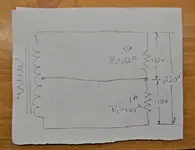M
malgovert
Member
Hi- I moved house about a year ago, sockets in new place all 110v, so as my equipment was a mix of 220v and dual voltage I bought a Bestek converter and a 220V plug Power strip and for a while everything worked fine. Then one day, I found that though my computer, monitor and Tascam Model 12 were still ok, my Genelec speakers, RNC, line 6 pod and the converter itself were all completely dead.
I bought 2 new Adam T5V speakers and a voltage stabilizer which made a light crackling noise from the moment I plugged it in, but everything seemed to be working. But one night soon after that the crackling got really loud and the stabilizer died on the spot.
By now all my gear was dual voltage so I decided to just run it from the 110v outlet via a surge protected power strip. Now one of the Adam speakers appears to have died - won’t switch on at all, no light no nothing. Checked the lead, the plug fuse, all good. So it seems it is the speaker.
So, it has to be the outlet, right, even though it is only 110v and the gear can take up to 240v? Or the wiring in the house? Though we’ve had no problem with any of the other outlets. I know nothing about electrics, so interested to hear any opinions or suggestions from those in the know. Been a protracted and painful (not to say costly) exercise trying to set this up. Thanks a lot.
I bought 2 new Adam T5V speakers and a voltage stabilizer which made a light crackling noise from the moment I plugged it in, but everything seemed to be working. But one night soon after that the crackling got really loud and the stabilizer died on the spot.
By now all my gear was dual voltage so I decided to just run it from the 110v outlet via a surge protected power strip. Now one of the Adam speakers appears to have died - won’t switch on at all, no light no nothing. Checked the lead, the plug fuse, all good. So it seems it is the speaker.
So, it has to be the outlet, right, even though it is only 110v and the gear can take up to 240v? Or the wiring in the house? Though we’ve had no problem with any of the other outlets. I know nothing about electrics, so interested to hear any opinions or suggestions from those in the know. Been a protracted and painful (not to say costly) exercise trying to set this up. Thanks a lot.


